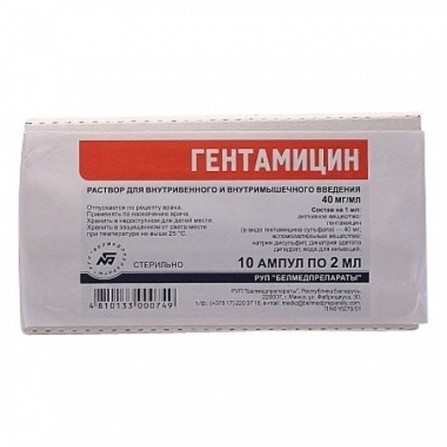Gentamicin, solution for inject 40mg 2ml N10
Condition: New product
Rating:
Be the first to write a review!

More info
Active ingredients
Gentamicin
Release form
Solution
Composition
Every 2 ml of solution for injection (1 ampoule) contains 80 mg of gentamicin in the form of sulfate.
Pharmacological effect
Gentamicin is an antibiotic of the group of aminoglycosides, gentamicin acts bactericidal, actively penetrating the cell membrane of bacteria and disrupting protein synthesis, binding to the subunit of 30S bacterial ribosomes. It has good activity against most gram-negative and some gram-positive bacteria. Especially effective in the treatment of infections caused by gram-negative organisms. Ineffective against Streptococcus spp., Including Streptococcus pneumoniae, as well as anaerobes.
Indications
Gentamicin is used in the treatment of severe systemic infections in which less toxic antibacterial agents are ineffective or contraindicated. - Sepsis (including sepsis of newborns) - Severe complications and recurrent urinary tract infections - Infections of the lower respiratory tract - Infections of the skin, bones, soft tissues and burnt tissue - Infections of the central nervous system (including meningitis) in combination with beta-lactam antibiotics. Gentamicin is the drug of choice in the treatment of severe bacterial infections caused by gram-negative microorganisms and infections accompanying diseases that reduce body resistance (neutropenia, diabetes, corticosteroid therapy, etc.) as well as in combination with beta-lactam antibiotics or clindamycin for empirical therapy of severe polymicrobial infections.
Contraindications
Hypersensitivity to antibiotics of the aminoglycoside group.
Dosage and administration
The dosage regimen is set individually, taking into account the severity of the course and localization of the infection, the sensitivity of the pathogen. When in / in or in / m administration for adults, a single dose is 1-1.7 mg / kg, daily dose - 3-5 mg / kg; the frequency of administration is 2-4 times / day. The course of treatment is 7-10 days. Depending on the etiology of the disease, it is possible to use at a dose of 120-160 mg 1 time / day. within 7-10 days or 240-280 mg once. In / in infusion is carried out within 1-2 hours. For children over 2 years old, the daily dose of gentamicin is 3-5 mg / kg; the frequency of administration is 3 times / day. Premature and newborn babies are prescribed in a daily dose of 2-5 mg / kg; the frequency of administration is 2 times a day; children up to 2 years old are prescribed the same dose at a frequency of 3 times / day. Patients with impaired renal excretory function require correction of the dosing regimen, depending on the values of QC.The maximum daily dose: for adults and children with a / in or / m injection - 5 mg / kg.
Side effects
In vitro. Since gentamicin forms complex compounds with many drugs, gentamicin cannot be mixed in the same syringe or vial with any other medicine. Antimyastenic agents. As with the use of other aminoglycosides, concurrent use of gentamicin may counteract the effect of anti-myasthenic drugs on skeletal muscles, and it may be necessary to adjust the doses of anti-myasthenic drugs. Neurotoxic and / or nephrotoxic drugs (in particular, other aminoglycosides, cephaloridine, paromomycin, viomycin, polymyxin B, colistin, vancomycin). Concurrent or sequential use is not recommended due to the increased risk of о- and / or nephrotoxicity. Loop diuretics. Co-administration with aminoglycosides, including gentamicin, should be avoided, as this may increase the toxicity of aminoglycosides. Means blocking neuromuscular transmission. Due to the combined use of aminoglycosides (in particular, gentamicin) and muscle relaxants, halogenated hydrocarbons as anesthetics, opioid analgesics and large amounts of blood with citrate preservatives, neuromuscular blockade may increase, leading to weakness of the skeletal muscles until respiratory arrest. Calcium and neostigmine can relieve neuromuscular blockade caused by succinylcholine and tubocurarine, respectively. Penicillins (for example, co-amoxiclav). The combination with gentamicin has a synergistic effect on enterococci. Because of the possible significant mutual inactivation with simultaneous administration, the drugs are administered at different times or in different parts of the body with simultaneous administration. Fluoroquinolones (eg, pefloxacin). The combination with gentamicin acts synergistically in relation to Pseudomonas aeruginosa, which allows to reduce the dose of gentamicin and, as a consequence, the likelihood of oto-and nephrotoxicity. Because of the possible significant mutual inactivation with simultaneous administration, the drugs are administered at different times or in different parts of the body with simultaneous administration.
Interaction with other drugs
Precautionary measures
special instructions
As with other aminoglycosides, in patients receiving high doses of gentamicin or undergoing a long course of treatment, there is a risk of developing nephrotoxic or neurotoxic (in particular, ototoxic) side effects. Other side effects: increased serum levels of hepatic transaminases, bulirubin, urea and creatinine, cylindruria, proteinuria, anemia, granulocytopenia, fever, skin rash, itching, urticaria, nausea, vomiting, headache, drowsiness.






